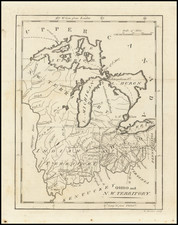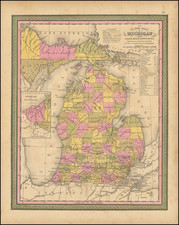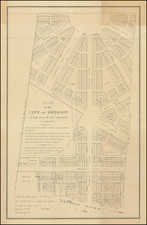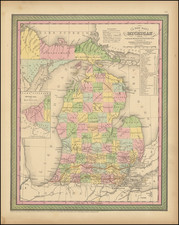Rare early plan of Detroit from the first edition of the American State Papers. This map was produced as part of a federal effort to resolve the disputes which had arisen over the planned layout of the city of Detroit.
The 1805 Detroit fire necessitated the design of a new city plan, an effort that was spearheaded by Augustus Woodward. Inspired by the l'Enfant layout of Washington, D.C., Woodward planned a city with broad avenues and a central circus. While this plan was accepted, the continued expansion of the city led to disagreements over the interpretation of this original map. Notably, some surveyors attempted to deviate away from Woodward's "radial" design, as this was projected to render land less valuable than a typical block design. Further, the extent of waterfront development was heavily debated as some owners feared losing river access. This controversy eventually reached the federal legislature, hence the inclusion of this map (along with two competing designs) in the American State Papers.
This example of the map shows the proposed map layout of downtown Detroit from Grand Circus to the waterfront. Major streets, plot numbers, churches, and more are all shown. This map also includes an additional leaf showing plots off of Larned Street and Bates Street. The extension onto the waterfront, one of the main points of disagreement in the planning of Detroit, is seen at the bottom of the page.
The Judd Map of Detroit
The Judd map, which the presented example is based on, was one of the competing plans proposed for the layout of Detroit southeast of Campus Mauritius. Judd's map was produced when Woodward's map required updating following the decommissioning of Fort Shelby (point E on the presented map). Judd's vision for the part of the city newly available to development was to continue Woodward's original radial design. However, a contrasting map by John Mullet preferred a more block-and-grid approach. While some compromises between the competing visions were attempted, it would be the Mullet map that most resembles Detroit south of Michigan Avenue today.











![Lake Superior [Canoes in a Fog, Lake Superior]](https://storage.googleapis.com/raremaps/img/small/101468.jpg)

![[ The Old Northwest Territory ] Il Paese De Selvaggi Outagamiani, Mascoutensi Illinesi E parte Delle VI Naxioni](https://storage.googleapis.com/raremaps/img/small/75927.jpg)
